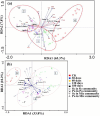Early allelopathic input and later nutrient addition mediated by litter decomposition of invasive Solidago canadensis affect native plant and facilitate its invasion
- PMID: 39748819
- PMCID: PMC11693450
- DOI: 10.3389/fpls.2024.1503203
Early allelopathic input and later nutrient addition mediated by litter decomposition of invasive Solidago canadensis affect native plant and facilitate its invasion
Abstract
Litter decomposition is essential for nutrient and chemical cycling in terrestrial ecosystems. Previous research on in situ litter decomposition has often underestimated its impact on soil nutrient dynamics and allelopathy. To address this gap, we conducted a comprehensive study involving both field and greenhouse experiments to examine the decomposition and allelopathic effects of the invasive Solidago canadensis L. in comparison with the native Phalaris arundinacea L. In the field, a 6-month litter bag experiment using leaf litter from S. canadensis and P. arundinacea was conducted across three community types: invasive, native, and mixed. Seed germination tests were also performed to investigate the allelopathic effects of decomposing litter. In the greenhouse, a pot experiment with lettuce as a bioindicator was performed to examine the allelochemical inputs from litter decomposition over various time intervals (0, 30, 60, 120, and 180 days). Subsequently, a soil-plant feedback experiment was carried out to further evaluate the effects of decomposing litter on soil biochemistry and plant dynamics. The findings of this study revealed that S. canadensis litter decomposed more rapidly and exhibited greater nitrogen (N) remaining mass compared with P. arundinacea in both single and mixed communities. After 180 days, the values for litter mass remaining for S. canadensis and P. arundinacea were 36% and 43%, respectively, when grown separately and were 32% and 44%, respectively, in mixed communities. At the invasive site, the soil ammonia and nitrate for S. canadensis increased gradually, reaching 0.89 and 14.93 mg/kg by day 120, compared with the native site with P. arundinacea. The soil organic carbon for S. canadensis at the invasive site also increased from 10.6 mg/kg on day 0 to 15.82 mg/kg on day 120, showing a higher increase than that at the native site with P. arundinacea. During the initial decomposition stages, all litters released almost all of their allelochemicals. However, at the later stages, litters continued to input nutrients into the soil, but had no significant impact on the soil carbon (C) and N cycling. Notably, litter-mediated plant-soil feedback facilitated the invasion of S. canadensis. In conclusion, this study highlights the significance of litter decomposition as a driver of transforming soil biochemistry, influencing the success of invasive S. canadensis.
Keywords: allelopathy; carbon and nitrogen cycle; invasion success; invasive species; plant-soil-feedback.
Copyright © 2024 Sun, Fu, Hu, Bo, Nawaz, Javed, Khattak, Akbar, Xiaoyan, Liu and Du.
Conflict of interest statement
The authors declare that the research was conducted in the absence of any commercial or financial relationships that could be construed as a potential conflict of interest.
Figures






References
-
- Adomako M. O., Ning L., Tang M., Du D.-L., Van Kleunen M., Yu F.-H. (2019). Diversity-and density-mediated allelopathic effects of resident plant communities on invasion by an exotic plant. Plant Soil. 440, 581–592. doi: 10.1007/s11104-019-04123-9 - DOI
-
- Adomako M. O., Xue W., Du D.-L., Yu F.-H. (2021). Soil biota and soil substrates influence responses of the rhizomatous clonal grass Leymus chinensis to nutrient heterogeneity. Plant Soil. 465, 19–29. doi: 10.1007/s11104-021-04967-0 - DOI
-
- Angst G., Pokorný J., Mueller C. W., Prater I., Preusser S., Kandeler E., et al. . (2021). Soil texture affects the coupling of litter decomposition and soil organic matter formation. Soil Biol. Biochem. 159, 108302. doi: 10.1016/j.soilbio.2021.108302 - DOI
LinkOut - more resources
Full Text Sources
Miscellaneous

